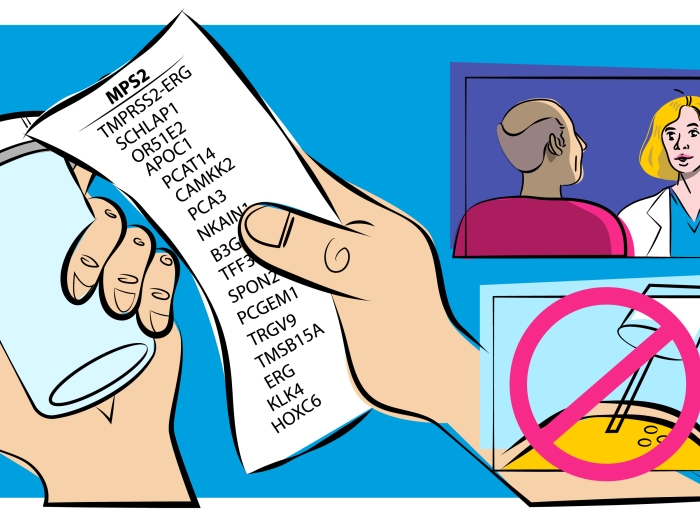But among those diagnosed, treatment rates remain high, despite increasing evidence that surveillance may be an appropriate option.
4:00 PM
Author |

As some national guidelines now recommend against routine prostate cancer screening, the overall rate of men receiving treatment for the disease declined 42 percent, a new study finds.
MORE FROM THE LAB: Subscribe to our weekly newsletter
The decline reflects efforts to decrease overdiagnosis and overtreatment — preventing some unnecessary treatments that can negatively impact long-term quality of life, while still providing lifesaving care to patients who need it.
But among those who are diagnosed, only 8 percent fewer are getting initial surgery or radiation treatments, even as data shows those with low-risk disease can substitute surveillance.
"It's not entirely surprising: Primary care doctors who perform the majority of screening were the target audience of U.S. Preventive Services Task Force guidelines recommending against screening. But the specialists who treat prostate cancer once it's diagnosed had a more tempered response," says study author Tudor Borza, M.D., M.S., a urologic oncology and health services research fellow at the University of Michigan.
In a study published in Health Affairs, University of Michigan researchers used Medicare claims data to identify 67,023 men newly diagnosed with prostate cancer between 2007 and 2012. Nearly three-quarters of those men had initial curative treatment, such as surgery or radiation.
If we get better predicting who's at highest risk, we can more accurately tailor screening and treatment.Tudor Borza, M.D., M.S.
In comparing overall treatment rates from 2007 till 2012, researchers found a sharp decrease of 42 percent, reflecting a change in screening recommendations and adoption of surveillance strategies in select groups of men. In 2008, the U.S. Preventive Services Task Force advised against routine screening in men older than 75. By 2011, a recommendation came out against all PSA screening.
But specialty societies, such as the American Urological Association, continued to advocate for screening in men who were most likely to benefit.
"These findings suggest that primary care doctors significantly decreased the number of patients to whom they recommended PSA screening after the guidelines changed," Borza says. "Primary care doctors make recommendations for screening to men who do not have cancer. They see men who have been treated for prostate cancer and have long-term effects, such as incontinence or impotence. That favors a less aggressive approach to the disease."
While screening recommendations became less aggressive, so did attitudes toward treatment. But researchers found a more tempered response when they looked at treatment rates over time among those diagnosed with prostate cancer.
Some prostate cancers are so slow-growing that data suggests the risks of treatment may outweigh the benefits. Watchful waiting or active surveillance, which involve monitoring patients without delivering treatment, are options, especially for those patients with low-risk disease or limited life expectancy. By monitoring these patients, urologists can identify when treatment may become necessary.
But even as this paradigm shifted, treatment rates moved slowly. Only 8 percent fewer diagnosed patients received treatment over the time frame studied.
"Specialists understand how insidious prostate cancer can be. They recognize the problems arising from overdiagnosis and overtreatment, but they also see people suffering from painful metastases or dying from the disease. When you're exposed to that, you're likely going to have a more reserved approach toward surveillance strategies," Borza says.
The study drilled down in particular on patients who had a high risk of dying from a cause other than prostate cancer within 10 years. This could be due to advanced age or multiple medical problems such as heart disease.
SEE ALSO: Quality of Life Meets Cure for Prostate Cancer Treatment
"If we had expected a big change in treatment for observation, it would have been in this group," Borza says. "These are the men for whom most physicians agree the risks of treatment outweigh the benefits. But there was no change in their treatment rate, meaning that adoption of less aggressive treatment strategies is occurring more slowly than the decrease in PSA screening."
The researchers recommend new payment models or other policies that emphasize value of care over volume, which might provide more incentive for specialists to choose observation over treatment. They also urge participation in quality improvement initiatives, such as the Michigan Urological Surgery Improvement Collaborative, which strive to provide high-quality, evidence-based care.
In addition, research continues to uncover new clues to identify which men are at highest risk of aggressive prostate cancer and could most benefit from screening and treatment.
"That's really the concern here. We know prostate cancer is a deadly disease in some men. We need better tools to identify which men should be screened and among those diagnosed, which men should be treated aggressively. This is still a black box. It's that uncertainty that leads to different approaches to treatment based on how different physicians view the risk. If we get better predicting who's at highest risk, we can more accurately tailor screening and treatment," Borza says.

Explore a variety of healthcare news & stories by visiting the Health Lab home page for more articles.

Department of Communication at Michigan Medicine
Want top health & research news weekly? Sign up for Health Lab’s newsletters today!





